1998 PONTIAC GRAND PRIX hood open
[x] Cancel search: hood openPage 95 of 402

Engine Coolant Heater (If Equipped)
6
In very cold weather, 0 OF (- 18 O C) or colder, the engine
coolant heater
can help. You'll get easier starting and
better fuel economy during engine warm-up. Usually,
the coolant heater should be plugged in a minimum of
four hours prior to starting your vehicle.
To Use the Engine Coolant Heater
1. Turn off the engine.
2. Open the hood and unwrap the electrical cord. The
cord is located below the
air cleaner near the coolant
reservoir bottle.
3. Plug it into a normal, grounded 1 10-volt AC outlet.
I
A CAUTION:
-
Plugging the cord into an ungrounded outlet
could cause an electrical shock. Also, the wrong
kind
of extension cord could overheat and cause
a fire. You could be seriously injured. Plug the
cord into a properly grounded three-prong
110-volt
AC outlet. If the cord won't reach, use a
heavy-duty three-prong extension cord rated for
at least
15 amps.
4. Before starting the engine, be sure to unplug and store
the cord as it was before to keep it away from moving
engine parts. If you don't, it could be damaged.
2-20
Page 118 of 402
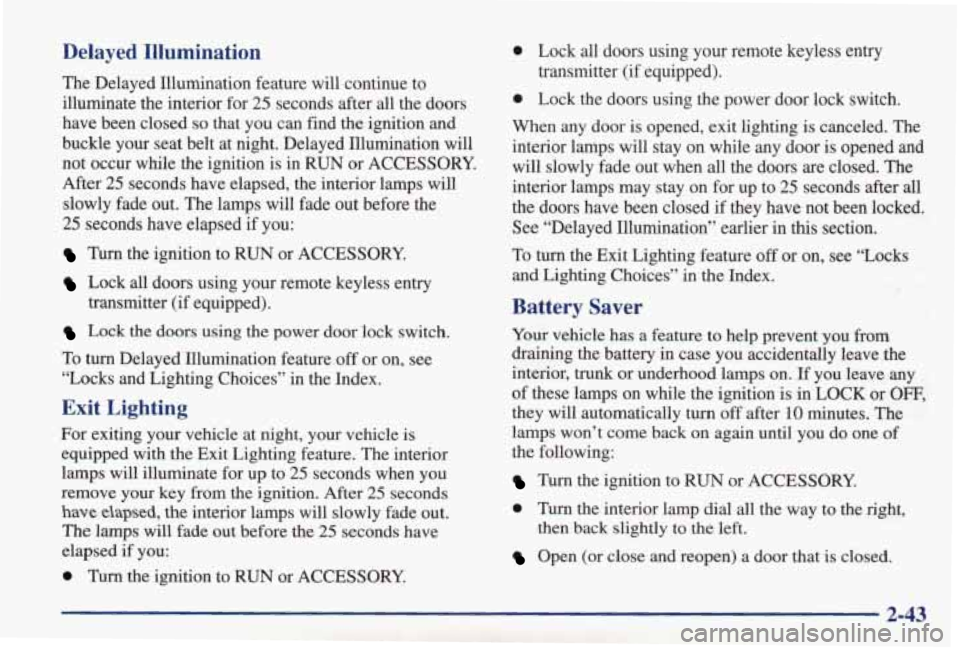
Delayed Illumination
The Delayed Illumination feature will continue to illuminate the interior for
25 seconds after all the doors
have been closed
so that you can find the ignition and
buckle your seat belt at night. Delayed Illumination will not occur while the ignition is in RUN or ACCESSORY.
After
25 seconds have elapsed, the interior lamps will
slowly fade out. The lamps will fade out before the
25 seconds have elapsed if you:
Turn the ignition to RUN or ACCESSORY.
Lock all doors using your remote keyless entry
Lock the doors using the power door lock switch.
To turn Delayed Illumination feature
off or on, see
“Locks and Lighting Choices” in the Index.
Exit Lighting
transmitter (if equipped).
For exiting your vehicle at night, your vehicle is
equipped with the Exit Lighting feature. The interior
lamps will illuminate for up to
25 seconds when you
remove your key from the ignition. After
25 seconds
have elapsed, the interior lamps will slowly fade out.
The lamps will fade out before the
25 seconds have
elapsed if you:
0 Turn the ignition to RUN or ACCESSORY.
0 Lock all doors using your remote keyless entry
0 Lock the doors using the power door lock switch.
When any door is opened, exit lighting is canceled. The
interior lamps will stay on while any door is opened and
will slowly fade out when all the doors are closed. The
interior lamps may stay on for up to
25 seconds after all
the doors have been closed if they have not been locked.
See “Delayed Illumination” earlier
in this section.
To turn the Exit Lighting feature
off or on, see “Locks
and Lighting Choices” in the Index.
Battery Saver
Your vehicle has a feature to help prevent you from
draining the battery in case you accidentally leave the
interior, trunk or underhood lamps on. If you leave any
of these lamps on while the ignition is in LOCK or
OFF,
they will automatically turn off after 10 minutes. The
lamps won’t come back on again until you do one of
the following:
Turn the ignition to RUN or ACCESSORY.
0 Turn the interior lamp dial all the way to the right,
Open (or close and reopen) a door that is closed.
transmitter (if equipped).
then back slightly to
the left.
2-43
Page 251 of 402
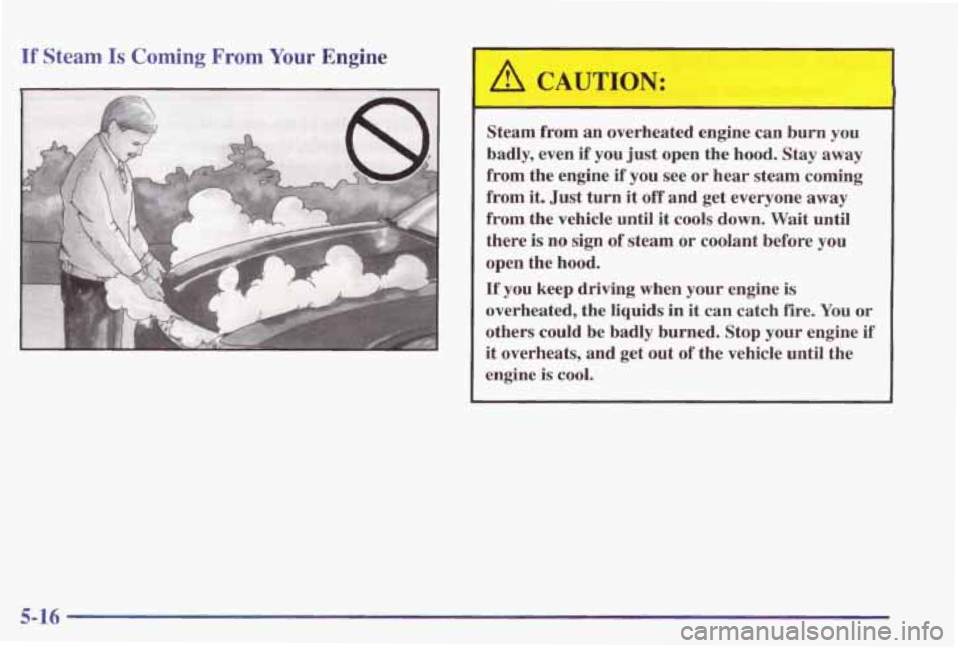
If Steam Is Coming From Your Engine
A CAUTION:
-
Steam from an overheated engine can burn you
badly, even if you just open the hood. Stay away
from the engine
if you see or hear steam coming
from
it. Just turn it off and get everyone away
from the vehicle until it cools down. Wait until
there
is no sign of steam or coolant before you
open the hood.
If you keep driving when your engine is
overheated, the liquids in
it can catch fire. You or
others could be badly burned. Stop your engine if
it overheats, and get out of the vehicle until the
engine is cool.
5-16
Page 252 of 402
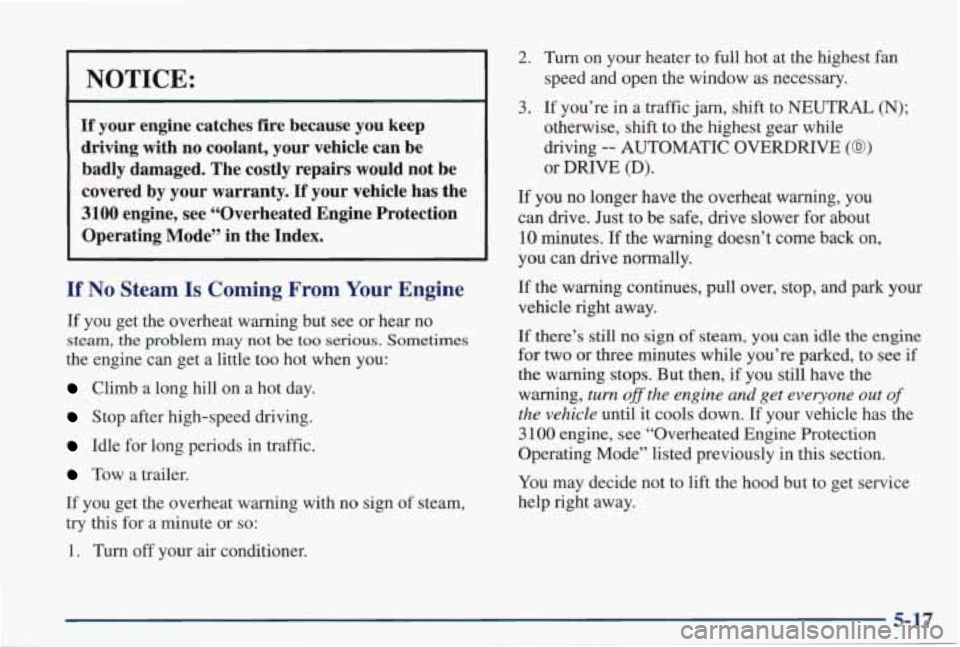
NOTICE:
If your engine catches fire because you keep
driving with no coolant, your vehicle can be
badly damaged. The costly repairs would not be
covered by your warranty.
If your vehicle has the
3100 engine, see “Overheated Engine Protection
Operating Mode” in the Index.
If No Steam Is Coming From Your Engine
If you get the overheat warning but see or hear no
steam, the problem may not be too serious. Sometimes
the engine can get a little too hot when you:
Climb a long hill on a hot day.
Stop after high-speed driving.
Idle for long periods in traffic.
Tow a trailer.
If you get the overheat warning with no sign of steam,
try this for a minute or so:
1. Turn off your air conditioner.
2. Turn on your heater to full hot at the highest fan
speed and open the window as necessary.
3. If you’re in a traffic jam, shift to NEUTRAL (N);
otherwise, shift to the highest gear while
driving
-- AUTOMATIC OVERDRIVE (03)
or DRIVE (D).
If you no longer have the overheat warning, you
can
drive. Just to be safe, drive slower for about
10 minutes. If the warning doesn’t come back on,
you can
drive normally.
If the warning continues, pull over, stop, and park
your
vehicle right away.
If there’s still no sign of steam, you can idle the engine
for two or three minutes while you’re parked, to see if
the warning stops. But then, if you still have the
warning,
turn off the engine and get everyone out of
the vehicle until it cools down. If your vehicle has the
3 100 engine, see “Overheated Engine Protection
Operating Mode” listed previously in this section.
You may decide not to lift the hood but to get service
help right away.
5-17
Page 279 of 402
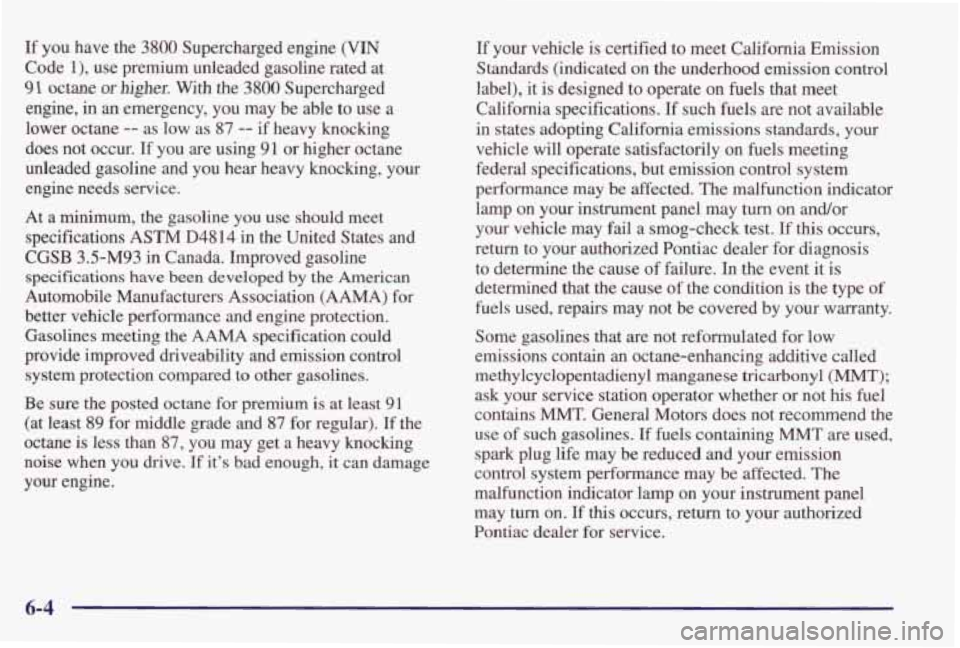
If you have the 3800 Supercharged engine (VIN
Code l), use premium unleaded gasoline rated at
91 octane or higher. With the 3800 Supercharged
engine, in
an emergency, you may be able to use a
lower octane
-- as low as 87 -- if heavy knocking
does not occur. If you are using 91 or higher octane
unleaded gasoline and you hear heavy knocking, your engine needs service.
At a minimum, the gasoline you
use should meet
specifications
ASTM D4814 in the United States and
CGSB 3.5-M93 in Canada. Improved gasoline
specifications have been developed by the American
Automobile Manufacturers Association
(AAMA) for
better vehicle performance and engine protection. Gasolines meeting
the AAMA specification could
provide improved driveability and emission control system protection compared to other gasolines.
Be sure the posted octane for premium
is at least 91
(at least 89 for middle grade and 87 for regular). If the
octane is less than
87, you may get a heavy knocking
noise
when you drive. If it’s bad enough, it can damage
your engine.
If your vehicle is certified to meet California Emission
Standards (indicated on the underhood emission control
label), it is designed to operate on fuels that meet
California specifications. If such fuels are not available
in states adopting California emissions standards, your
vehicle will operate satisfactorily on fuels meeting
federal specifications, but emission control system
performance may be
affected. The malfunction indicator
lamp on your instrument panel may turn on andor
your vehicle may fail a smog-check test.
If this occurs,
return to your authorized Pontiac dealer for diagnosis
to determine the cause of failure.
In the event it is
determined that the cause
of the condition is the type of
fuels used, repairs may not be covered by your warranty.
Some gasolines that are not reformulated for low
emissions contain
an octane-enhancing additive called
methylcyclopentadienyl manganese tricarbonyl
(MMT);
ask your service station operator whether or not his fuel
contains
MMT. General Motors does not recommend the
use
of such gasolines. If fuels containing MMT are used,
spark plug life may be reduced and your emission
control system performance may be affected. The
malfunction indicator lamp on your instrument panel
may turn on. If
this occurs, return to your authorized
Pontiac dealer for service.
6-4
Page 283 of 402
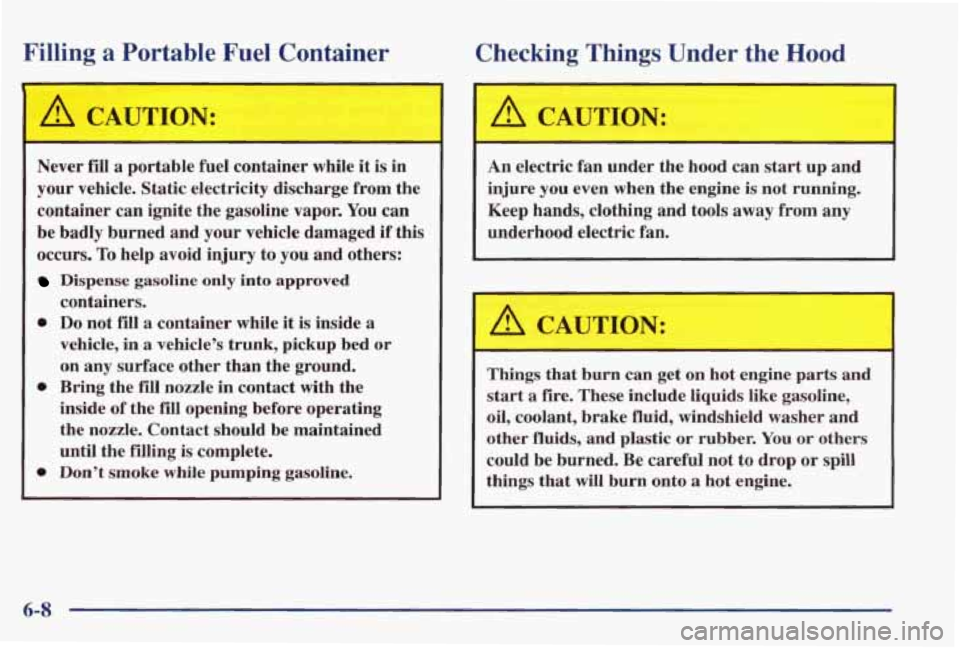
Filling a Portable Fuel Container
A CAUTION:
Never fill a portable fuel container while it is in
your vehicle. Static electricity discharge from the
container can ignite the gasoline vapor. You can
be badly burned and your vehicle damaged
if this
occurs.
To help avoid injury to you and others:
Dispense gasoline only into approved
containers.
0 Do not fill a container while it is inside a
vehicle, in a vehicle’s trunk, pickup bed
or
on any surface other than the ground.
0 Bring the fill nozzle in contact with the
1 inside of the fill opening before operating
the nozzle. Contact should be maintained
1 until the filling is complete.
~ 0 Don’t smoke while pumping gasoline.
i
Checking Things Under the Hood
A CAUTION: I
An electric fan under the hood can start up and
injure you even when the engine
is not running.
Keep hands, clothing and tools away from any
underhood electric fan.
Things that burn can get on hot engine parts and
start a fire. These include liquids like gasoline,
1 oil, coolant, brake fluid, windshield washer and
other fluids, and plastic
or rubber. You or others
could be burned. Be careful not to drop or
spill
things that will burn onto a hot engine.
6-8
Page 284 of 402
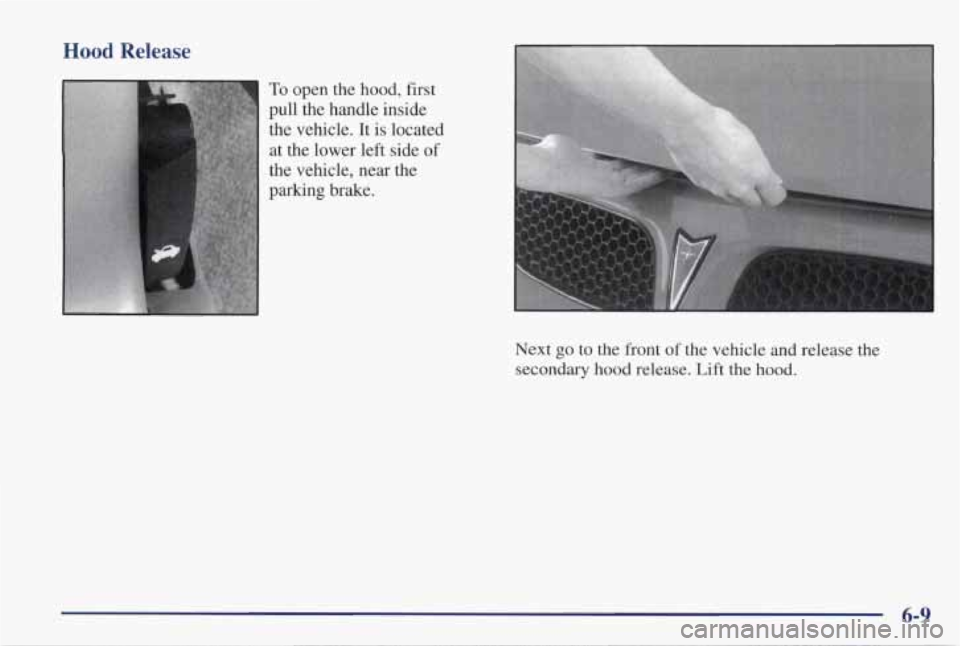
Hood Release
I To open the hood, first
pull the handle inside
the vehicle.
It is located
at the lower left side of
the vehicle, near the
parking brake.
6-9
Page 285 of 402
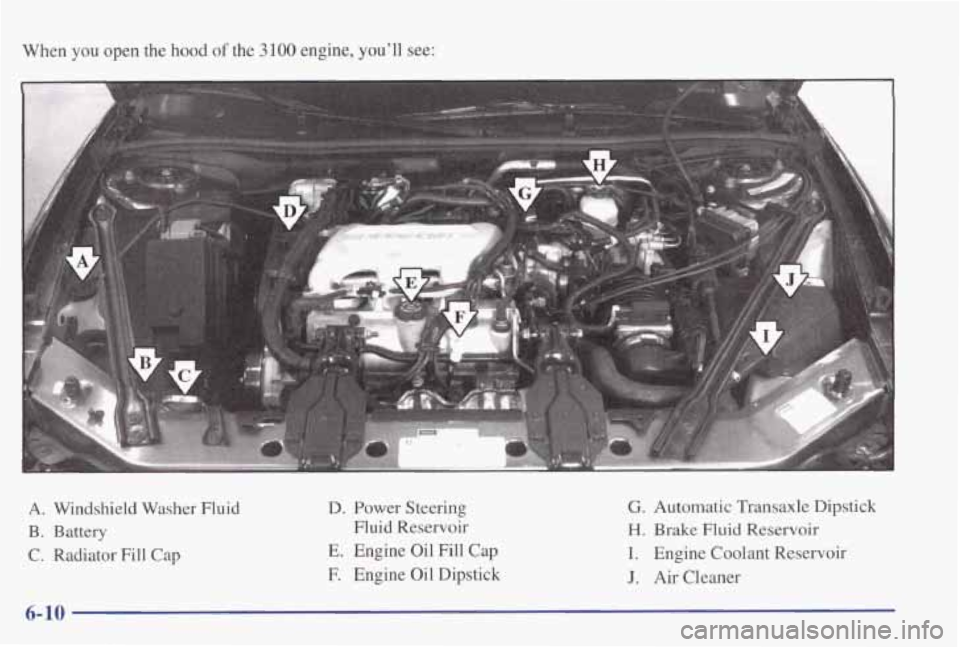
When you open the hood of the 3100 engine, you'll see:
n
A. Windshield Washer Fluid
B. Battery
C. Radiator Fill Cap
D. Power Steering
Fluid Reservoir
E. Engine Oil Fill Cap
E Engine Oil Dipstick G.
Automatic Transaxle Dipstick
H. Brake Fluid Reservoir
I. Engine Coolant Reservoir
J. Air Cleaner
6-10